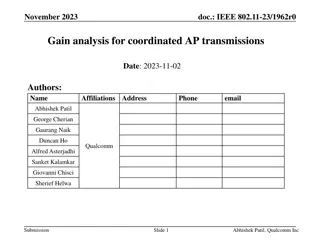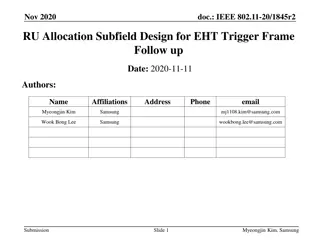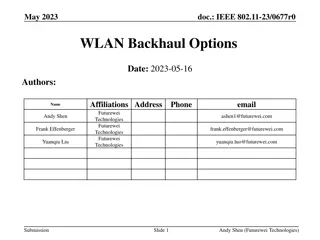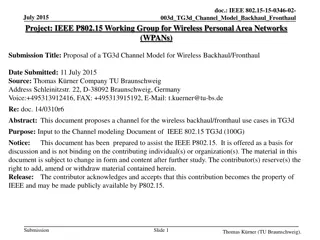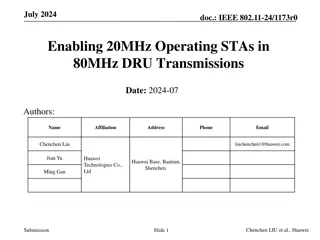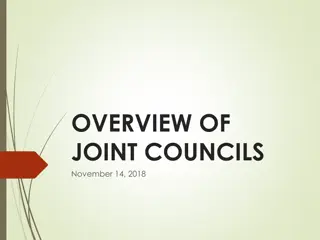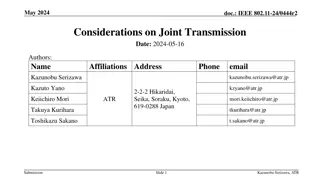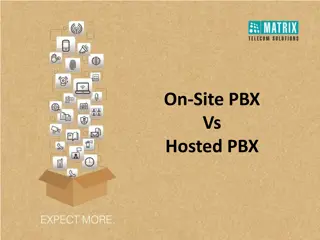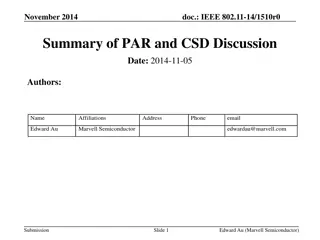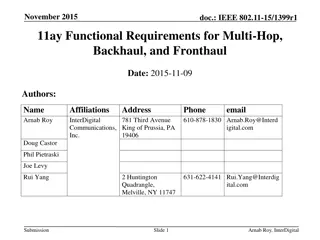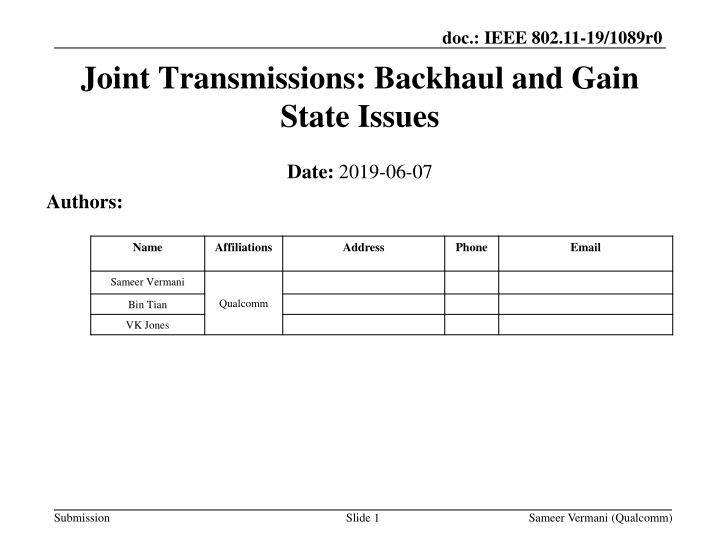
Key Insights into IEEE 802.11-19/1089r0 Joint Transmission Backhaul Issues
Discover the challenges and requirements related to backhaul and gain state issues in joint processing transmission, as discussed in the IEEE 802.11-19/1089r0 document. The content delves into the necessity of backhaul in JT, backhaul burden scenarios in retail and carrier markets, and key observations on backhaul requirements. Gain valuable insights into inter-AP synchronization, backhaul link considerations, and the impact of different deployment models on capacity in this informative document.
Uploaded on | 1 Views
Download Presentation

Please find below an Image/Link to download the presentation.
The content on the website is provided AS IS for your information and personal use only. It may not be sold, licensed, or shared on other websites without obtaining consent from the author. If you encounter any issues during the download, it is possible that the publisher has removed the file from their server.
You are allowed to download the files provided on this website for personal or commercial use, subject to the condition that they are used lawfully. All files are the property of their respective owners.
The content on the website is provided AS IS for your information and personal use only. It may not be sold, licensed, or shared on other websites without obtaining consent from the author.
E N D
Presentation Transcript
doc.: IEEE 802.11-19/1089r0 Joint Transmissions: Backhaul and Gain State Issues Date: 2019-06-07 Authors: Name Affiliations Address Phone Email Sameer Vermani Qualcomm Bin Tian VK Jones Submission Slide 1 Sameer Vermani (Qualcomm)
doc.: IEEE 802.11-19/1089r0 Introduction Joint processing transmission (JT) has been discussed as a candidate technology to be adopted in the EHT standard Substantial gains are on offer due to degrees of freedom gain from pooling together the antennas of multiple APs Presentations so far have focused on the following set of challenges Inter-AP synchronization of phase, frequency and timing These slides are an attempt to highlight The backhaul requirements of this technology Sensitivity to gain state errors across APs Submission Slide 2 Sameer Vermani (Qualcomm)
doc.: IEEE 802.11-19/1089r0 Need for Backhaul In JT, data of one user in transmitted from multiple APs Data of all participating STAs needs to be available at all APs (shared over backhaul) MU-MIMO using one giant precoder over the combined array consisting of the Tx antennas of all APs Backhaul Link AP2 AP1 BSS2 BSS1 Submission Slide 3 Sameer Vermani (Qualcomm)
doc.: IEEE 802.11-19/1089r0 Backhaul Burden In both retail and carrier markets, we have to assume the backhaul happens over the air Two possible deployment models a) Backhaul uses the same channel as fronthaul b) Backhaul uses a different channel as fronthaul In scenario a), the impact on capacity is very direct, where as in b), it s an indirect impact Submission Slide 4 Sameer Vermani (Qualcomm)
doc.: IEEE 802.11-19/1089r0 Key Observation about Backhaul Requirement The backhaul has to pump the same data that eventually gets transmitted from multiple APs in the downlink over the front-haul Assuming a model where the master AP is broadcasting the data of all users to slave APs The sum throughput across all recipient STAs over the front-haul needs to be supported over the backhaul as well Think of it like data being pumped into multiple APs, and the same data eventually being sprinkled onto recipient STAs over front-haul Submission Slide 5 Sameer Vermani (Qualcomm)
doc.: IEEE 802.11-19/1089r0 Example Case of four APs, 4 Tx each One of the APs is the master AP, and is connected to the internet backbone Needs to share the raw data of all participating users available at all APs Broadcasts the data of all STAs to the slave APs over backhaul Backhaul Data rates needed for Joint Transmissions at 80MHz Function of sum PHY data rates being supported over front-haul About 3.27 Gbps if using MCS5 (for 12ss total across APs) About 3.68 Gbps if using MCS6 (for 12ss total across APs) About 4.08 Gbps if using MCS7 (for 12ss total across APs) Note that this technique might need to send the precoder as well, but that should lead to negligible additional burden To support the backhaul data rates with 4ss, need 160MHz and MCS9 Submission Slide 6 Sameer Vermani (Qualcomm)
doc.: IEEE 802.11-19/1089r0 Amount of Backhaul Needed: General Trends Factors to consider about the backhaul link A. Limited by the number of spatial streams that can be supported at ONE AP AP with the min number of antennas limits the # of spatial streams in the backhaul link B. Maybe able to support a higher MCS since it is an open loop transmission Since factor A. is more dominant, we need more bandwidth in the backhaul than the front-haul The more the number of APs participating in a JT, the greater this discrepancy Factor A becomes more and more severe as number of APs grow E.g. For the 4 AP case, 80MHz Joint transmissions will not work with a 80MHz backhaul as shown in the last slide Note: Assumption of an AP being able to broadcast to all other APs at a high MCS (e.g., 4ss MCS9 as assumed in last slide) is already optimistic Submission Sameer Vermani (Qualcomm) Slide 7
doc.: IEEE 802.11-19/1089r0 Gain State Related Issues These issues mainly affect JT (and not other AP coordination flavors) Relative gain state during sounding stage across APs cannot be very different from that during actual transmission The relative gain of the channel across APs which is used for precoding should be very close to relative gain at the time of transmission Any difference beyond 0.8 dB needs to be corrected See next slide Sources of gain state difference The PA gain state of AP can be different during sounding and actual transmission AGC gains can be different at different APs for implicit sounding Moreover, difference in AGC gain state at a slave AP trying to phase synchronize to the master can also impact phase synch Changes in gain state for two consecutive sync signals can lead to phase shifts Might need to use a fixed AGC state at slave APs when receiving synch signals Submission
doc.: IEEE 802.11-19/1089r0 Gain Offset Impact: Joint Transmissions in DL Relative gain state during sounding stage across APs modeled to be different from that during actual transmission Below we show the sensitivity to relative gain state errors as a function of pathloss 2 BSSs: Each equipped with 8 antenna AP [2 2 2 2 2 2] Joint Transmission 40MHz BW Relative AGC state error Across APs in dB Submission
doc.: IEEE 802.11-19/1089r0 Conclusions In these slides we showed the following for JT Backhaul requirements For retail and carrier markets, where backhaul is over-the-air, backhaul needs higher BW than front-haul 80MHz JT needs 160MHz backhaul Sensitivity to PA or AGC gain state errors Sub-dB level accuracy needs to be maintained Submission Slide 10 Sameer Vermani (Qualcomm)
doc.: IEEE 802.11-19/1089r0 Feeding back precoded samples APPENDIX Submission Slide 11 Sameer Vermani (Qualcomm)
doc.: IEEE 802.11-19/1089r0 Other approach of doing backhaul Precoded data from a central processor to a 80MHz, four 4 Tx APs Assuming 80MHz, 980 tones need to be sent in 14.4 us (assuming 1.6 us CP) If 4 antennas at each AP are active, then every AP will be sent 4x980 I, Q samples in 14.4 us Assuming 8 bit I and 8 bit Q, this means 4x4x980x16 =62720*4 bits in 14.4 us = 17.4 Gbps This is independent of data rate being supported in the actual transmission (if bit-widths stay constant) Submission Slide 12 Sameer Vermani (Qualcomm)

